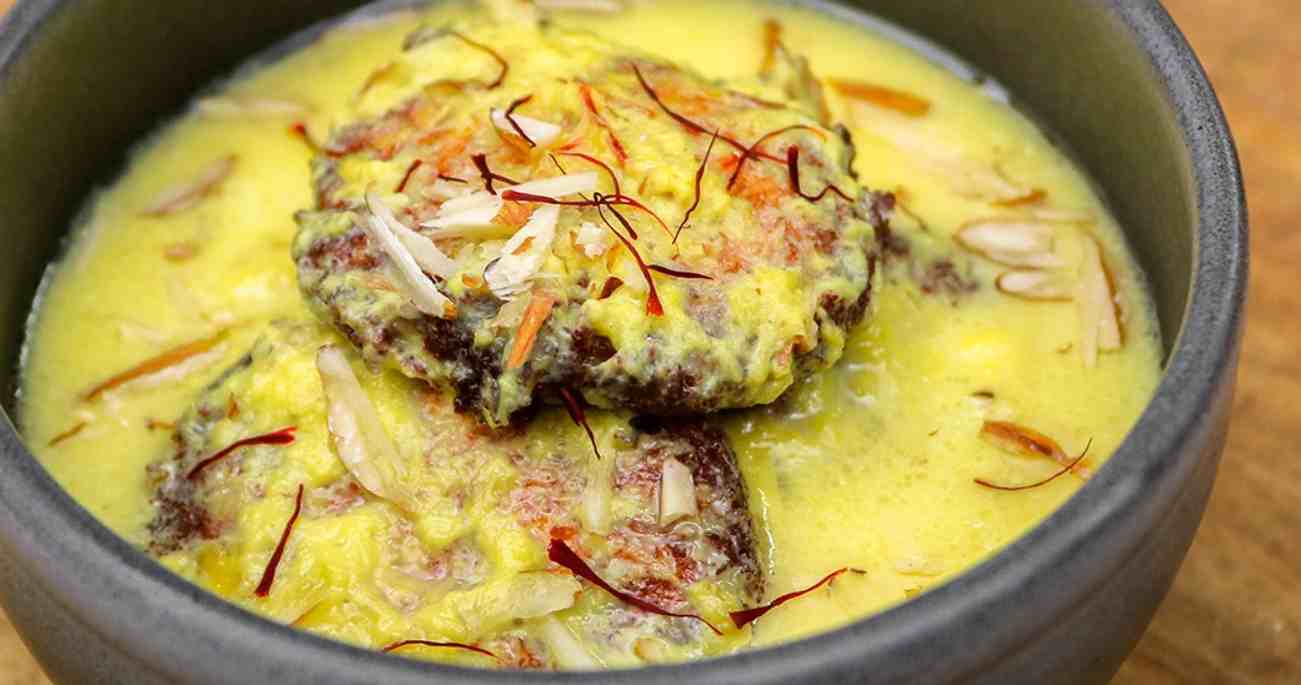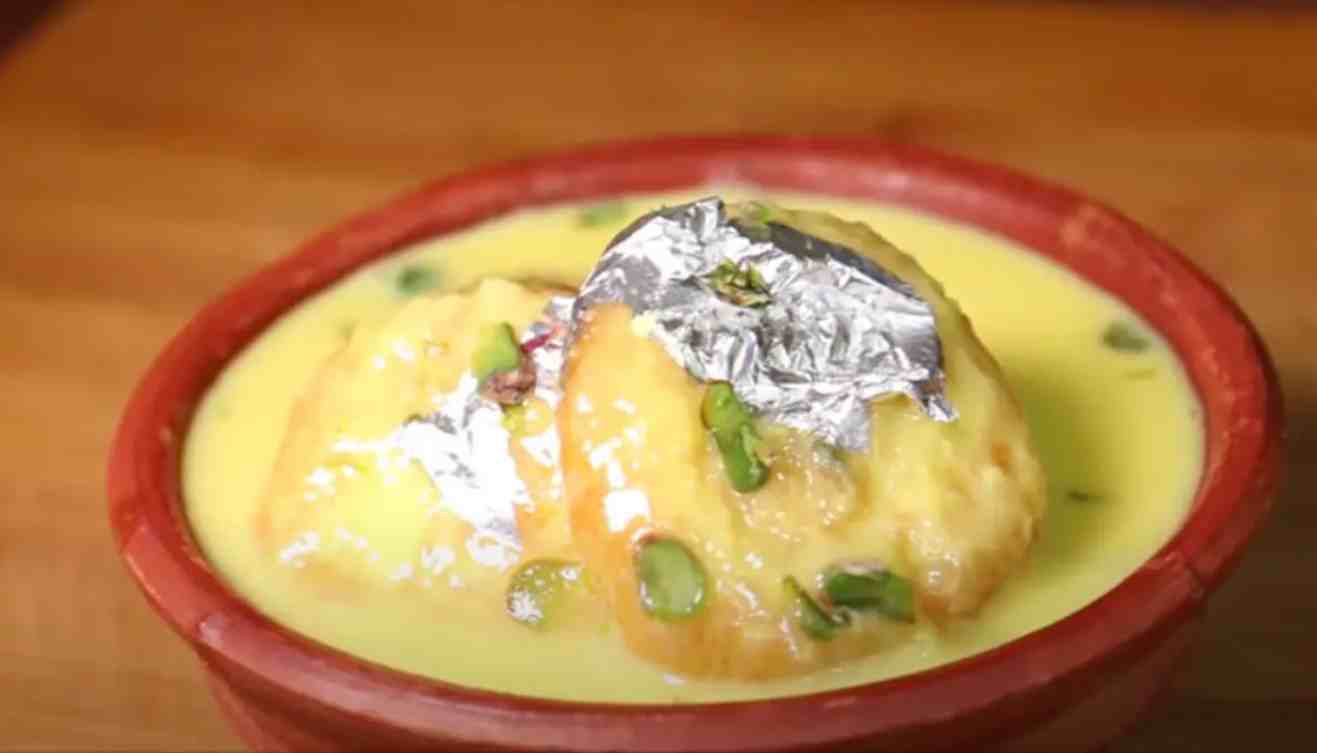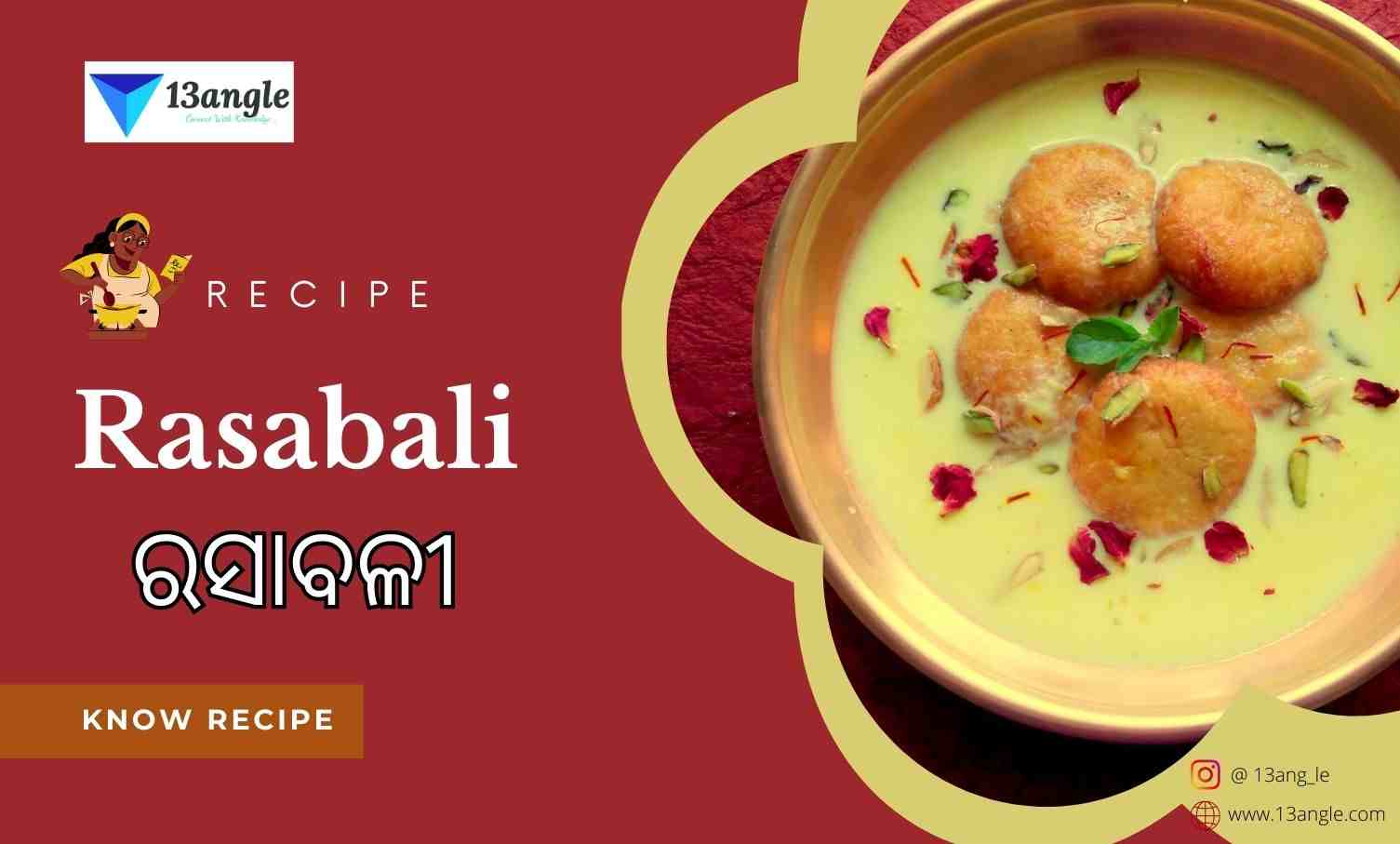- Umang Sagar
- 1 Comment
- Cuisine, Dessert & Sweets
Indulge In The Divine Symphony Of Flavours With Rasabali: A Sweet Odyssey From Odisha

Introduction
In the heartland of India, where traditions intertwine with devotion and culinary artistry, emerges a treat that transcends time itself – Rasabali. This ethereal delicacy hails from the mystical land of Odisha, a testament to the fusion of spirituality and gastronomy. With every bite, Rasabali encapsulates not only the rich heritage of the region but also the devotion and reverence that define its creation.
Rasabali isn’t just a dish; it’s a sacred offering to Baladevjew, with its origins nestled within the sanctified walls of the Baladevjew Temple in Kendrapara. Imagine the sun’s golden rays embracing the temple spires, setting the stage for a culinary masterpiece to unfold. Here, within the temple’s embrace, Rasabali takes form – a sweet wonder that carries the essence of faith, humility, and culinary ingenuity.
Crafted from chhena, the farmer’s cheese, Rasabali’s journey commences with delicate hands shaping this humble ingredient into flattened patties. The chhena, with its rustic charm, becomes a canvas for the artistry that follows. These reddish-brown patties, akin to small tokens of devotion, find their gentle immersion in a velvety pool of sweetened milk, known as rabri. In this bath of creamy opulence, a transformation takes place. The chhena patties, with their flattened form, evolve into vessels of absorption, eagerly soaking in the essence of the rabri.
But Rasabali’s allure doesn’t halt there. A delicate touch of crushed cardamom, like echoes of ancient melodies, adds a symphony of flavours that dance upon the taste buds – the gentle sweetness of the milk harmonizing with the earthiness of chhena, while the aromatic cardamom introduces a celestial fragrance.
With every succulent bite of Rasabali, you’re drawn into an age-old tradition that unites the spiritual and the earthly. What once was an offering to the divine has transformed into a symbol of Odisha’s cultural opulence and culinary finesse. As you savour the extraordinary blend of textures and tastes, remember that Rasabali isn’t just a sweet dish; it’s devotion incarnate, a testament to the timeless connection between humanity, nourishment, and faith.
So, let Rasabali be more than a mere dessert on your plate; let it be a journey that transports you to the sacred precincts of the Baladevjew Temple. There, devotion unfurls through the delicate interplay of flavors. With each delectable morsel, experience the devotion of generations past, the wisdom of tradition, and the culinary magic that only Odisha can conjure.
History And Origin

The history and origin of Rasabali sweet are intertwined with the cultural and religious heritage of Odisha, India. This delectable dessert holds a special place in the hearts of the people of Odisha and is closely associated with their devotion and culinary traditions.
Rasabali finds its roots in the ancient land of Odisha, where spirituality and cuisine have always been deeply interwoven. The sweet dish is closely connected to the Baladevjew Temple located in the town of Kendrapara. This temple is dedicated to Lord Balabhadra, a form of Lord Krishna, who is also known as Baladevjew. It is believed that Rasabali was initially created as an offering to appease and please Lord Baladevjew, one of the revered deities of the Jagannath Temple in Puri.
The historical narrative of Rasabali is embedded in the devotion of the devotees who sought to express their reverence through culinary artistry. Over the centuries, the dish evolved, gaining recognition and popularity not just as an offering to the gods, but also as a delightful culinary creation cherished by locals and visitors alike.
The preparation of Rasabali involves the use of chhena, a type of farmer’s cheese that is a staple in Odia cuisine. The chhena is meticulously kneaded and shaped into flat patties before being deep-fried to a reddish-brown hue. These patties are then immersed in a luscious pool of thickened, sweetened milk called rabri. The flattened shape of the chhena patties is intentionally designed to enhance their ability to absorb the rich flavours of the rabri, creating a harmonious blend of taste and texture.
To further elevate the flavour profile, crushed cardamom is often added to the dish, infusing it with an enchanting aroma and a touch of sophistication. The resulting combination of the creamy rabri, the delicately fried chhena, and the aromatic cardamom creates a sensory experience that is as much about spirituality as it is about culinary art.
Rasabali’s journey from being an offering of devotion to a beloved sweet enjoyed by all symbolizes the seamless fusion of culture, faith, and gastronomy. It serves as a bridge between the divine and the earthly, a testament to the rich history and traditions of Odisha. As you savour each bite of Rasabali, you partake in a centuries-old legacy that speaks of reverence, craftsmanship, and the enduring connection between food and spirituality.
Recipe

Ingredients:-
For Chhena Patties:
- 2 cups full-fat milk
- 2 tablespoons lemon juice or vinegar
- 1 cup sugar (for the sugar syrup)
- Oil or ghee for frying
For Rabri:
- 4 cups full-fat milk
- 1 cup sugar
- 1/2 teaspoon crushed cardamom
Instructions:-
Preparing Chhena:
- Begin by boiling 2 cups of milk in a heavy-bottomed pan.
- Once the milk starts boiling, reduce the heat and add lemon juice or vinegar. Stir gently until the milk curdles and the whey separates from the curd.
- Line a strainer or a muslin cloth with a fine sieve and strain the curdled milk to separate the chhena from the whey.
- Rinse the chhena under cold water to remove any trace of lemon juice or vinegar. Gather the cloth and gently squeeze out excess water.
- Hang the chhena in the cloth for about 30 minutes to remove excess moisture. This step is crucial for the right texture of the rasabali.
Preparing Sugar Syrup:
- In a wide pan, dissolve 1 cup of sugar in 3 cups of water and bring it to a boil.
- Once the sugar syrup starts boiling, add the chhena patties. Let them simmer for about 15-20 minutes, allowing them to absorb the syrup’s sweetness. This step imparts a delicate flavor to the chhena.
Frying Chhena Patties:
- Heat oil or ghee in a pan over medium heat.
- Gently take the soaked chhena patties out of the sugar syrup and carefully place them in the hot oil.
- Fry the patties until they turn golden brown on both sides. Once done, transfer them onto a plate lined with paper towels to drain excess oil.
Preparing Rabri:
- In a separate heavy-bottomed pan, pour 4 cups of milk and bring it to a boil.
- Reduce the heat and let the milk simmer, stirring occasionally, until it reduces to about half its original volume.
- Add 1 cup of sugar and crushed cardamom to the milk and continue to simmer, stirring frequently, until the milk thickens and attains a rabri-like consistency. This might take around 20-30 minutes.
Assembling Rasabali:
- Gently immerse the fried chhena patties into the thickened rabri, allowing them to soak up the rich flavours for a few minutes.
- Once the patties are well-soaked, remove them and place them in a serving dish.
Presentation and Serving:
- Pour a generous ladle of the prepared rabri over the chhena patties, ensuring they are well-coated.
- Optionally, garnish with chopped nuts like almonds, pistachios, or saffron strands for a visual and textural delight.
- Serve the Rasabali warm or chilled, letting its divine flavours enchant your taste buds.
Note: Remember that making Rasabali requires patience and attention to detail. The chhena patties should be delicate and the rabri should be velvety in texture. The cardamom adds a touch of fragrance that enhances the overall experience. Enjoy Rasabali as a delightful dessert or as a symbol of the rich culinary heritage of Odisha.
Why Rasabali Is Considered A Sacred Sweet And A Preferred Offering In Temples?
Rasabali holds a sacred significance and is often used as a bhog (devotional offering) in temples for several reasons deeply rooted in religious traditions and beliefs. Here’s why Rasabali is considered a sacred sweet and a preferred offering in temples:
Divine Offering: Rasabali is closely associated with Lord Baladevjew, a form of Lord Krishna, who is revered in the Baladevjew Temple in Kendrapara, Odisha. It is believed that offering Rasabali to the deity is a way of showing devotion and seeking blessings.
Culinary Devotion: Offering food to deities is an ancient practice in Hinduism, where it is believed that the essence of the food is shared with the divine. Rasabali’s preparation involves skill, dedication, and attention to detail, symbolizing the devotee’s culinary devotion to the deity.
Symbolism: The process of making Rasabali involves shaping chhena into flattened patties that symbolize humility and surrender. These patties are then immersed in sweetened milk, signifying the devotee’s immersion in the divine love and grace of the deity.
Spiritual Connection: Rasabali’s offering and consumption create a spiritual connection between the deity and the devotee. The act of partaking in the same food that is offered to the gods fosters a sense of unity and communion.
Sensory Experience: Rasabali engages multiple senses – sight, smell, touch, and taste – offering a holistic sensory experience that enhances the devotee’s connection with the divine.
Prasadam: Once offered to the deity, Rasabali becomes prasadam, which is considered blessed food imbued with divine energy. Devotees consume prasadam with reverence, believing it brings spiritual well-being and blessings.
Cultural Tradition: Rasabali’s history as a temple offering and its cultural significance have made it an integral part of temple rituals and festivals. Its honours tradition while celebrating the flavours of the region.
Bridging the Divine and Mundane: Rasabali bridges the gap between the divine and the earthly, demonstrating that even something as simple as food can be a medium for spiritual connection and expression of devotion.
Community Bonding: The distribution of prasadam, which often includes Rasabali, fosters a sense of community among devotees who come together to share in the blessings and partake in the sacred offering.
Rasabali’s status as a sacred sweet and bhog in temples is a testament to its role as a tangible expression of devotion, a means of connecting with the divine, and a symbol of the intricate intertwining of food, faith, and culture in the Indian spiritual landscape.
Top 13 Interesting Facts About Rasabali
Sacred Offering: Rasabali is a traditional sweet that holds religious significance in Odisha, India. It is often offered as bhog (devotional offering) to Lord Baladevjew in the Baladevjew Temple of Kendrapara.
Temple Origins: The origins of Rasabali can be traced back to the Baladevjew Temple, where it was initially prepared as an offering to appease and please the deity.
Connected to Jagannath Temple: Rasabali is also associated with the Jagannath Temple in Puri. It is considered one of the Chapana bhoga (56 types of offerings) that are offered to Lord Jagannath.
Chhena Magic: The core ingredient of Rasabali is chhena, a fresh farmer’s cheese. The chhena is skillfully shaped into patties before being immersed in rabri.
Milk Transformation: The rabri is made by thickening milk and sweetening it with sugar. The chhena patties are soaked in this luxurious concoction, transforming into a delightful treat.
Absorption Technique: The flattened shape of the chhena patties is designed to absorb the flavours of the rabri more effectively, creating a harmonious blend of taste and texture.
Cardamom Elegance: Rasabali is often infused with the delicate fragrance of crushed cardamom, adding an aromatic dimension to its flavour profile.
Culinary Craftsmanship: The process of making Rasabali requires culinary skill and precision, especially in frying the chhena patties to the perfect golden-brown hue.
Heritage Symbol: Rasabali serves as a symbol of Odisha’s rich cultural heritage and culinary finesse, showcasing the harmonious fusion of food and spirituality.
Seasonal Variation: Rasabali is more commonly prepared and enjoyed during festive occasions, especially during religious celebrations like Janmashtami and other temple festivals.
Texture and Taste: The combination of the soft and spongy chhena patties with the creamy and sweet rabri creates a unique contrast in texture and an unforgettable taste experience.
Local Delicacy: While Rasabali’s roots are in the temples, it has transcended its religious origin to become a beloved local delicacy, cherished by people of all ages.
Cultural Legacy: Rasabali is a testament to the enduring connection between food, devotion, and culture in Odisha, offering a glimpse into the traditions and values of the region.
(FAQs) About Rasabali Sweet
Rasabali is a traditional sweet dish from Odisha, India. It consists of chhena (farmer’s cheese) patties that are deep-fried and then soaked in sweetened and thickened milk (rabri), often seasoned with crushed cardamom.
Rasabali is considered special due to its close association with temple rituals and offerings. It’s often offered as bhog (devotional offering) to deities in temples, symbolizing devotion and reverence.
Rasabali is offered to Lord Baladevjew, a form of Lord Krishna, in temples like the Baladevjew Temple in Kendrapara. The offering symbolizes devotion, humility, and the desire for divine blessings.
Yes, absolutely! While Rasabali has its roots in temple offerings, it has become a popular sweet enjoyed by people in Odisha and beyond. It’s relished during festivals, special occasions, and as a cultural delicacy.
Rasabali is made by shaping chhena into flattened patties, frying them until golden brown, and then soaking them in sweetened milk (rabri). The flattened shape of the chhena patties helps them absorb the flavors of the rabri.
Flattening the chhena patties allows them to absorb the sweetened milk (rabri) more effectively. The flattened shape increases the surface area and enhances the overall taste and texture.
Rabri is a rich and sweetened milk preparation that is thickened by simmering milk for an extended period. It forms the base in which chhena patties are soaked in Rasabali preparation.
Rasabali can be enjoyed both ways. Some prefer it warm, while others like it chilled. It’s a matter of personal preference.
While the basic Rasabali recipe remains the same, there might be slight regional variations in terms of flavorings, garnishes, or preparation techniques.
Rasabali is often prepared and enjoyed during festivals like Janmashtami and other temple celebrations. It’s also a delightful addition to special occasions and gatherings.
Yes, Rasabali can be made at home. The process requires some culinary skill, especially in handling the chhena patties and preparing the rabri.
Yes, Rasabali can be considered gluten-free since it is primarily made from chhena (cheese) and milk. However, it’s always a good idea to confirm the ingredients’ gluten-free status before consuming.
Rasabali’s unique combination of deep-fried chhena patties soaked in rabri sets it apart. The delicate balance of textures and the aromatic touch of cardamom make it distinctively flavorful. Its association with spirituality and temple rituals further adds to its uniqueness.




ଜୟ ଜଗନ୍ନାଥ🙏
ରସାବଳୀ, ଏହା ସମସ୍ତ ମିଠା ମଧ୍ୟରୁ ମୋର ପ୍ରିୟ। ମୁଁ ଓଡ଼ିଶାର ନିବାସୀ ଅଟେ, ଏବଂ ମୋତେ ଏହା ଜାଣି ବହୁତ ଖୁସି ଲାଗେ ଯେ ଏହାକୁ କେବଳ ଓଡ଼ିଶାର ଲୋକେ ହିଁ ପସନ୍ଦ କରନ୍ତି ନାହିଁ ବରଂ ଅଲଗା ସ୍ଥାନ ମାନଙ୍କରେ ମଧ୍ୟ ଏହି ମିଠାକୁ ବହୁତ ପସନ୍ଦ କରିଥାନ୍ତି। ମୁଁ ଆଗରୁ ଏହି recipe ବିଷୟରେ ଜାଣିଛି କିନ୍ତୁ ଏହି website ରୁ ଅଧିକ ଜାଣିବାକୁ ପାଇଲି। ଏଣୁ “13angle” ରେ ଆପଣଙ୍କୁ ଏବଂ ଆପଣଙ୍କର whole team କୁ ମୁଁ ଧନ୍ୟବାଦ ଦେବା ପାଇଁ ଚାହୁଁଛି। ଆଶା କରୁଛି କି ଆପଣ ଏଇଭଳି information ଆମକୁ ଦେଉଥାଆନ୍ତୁ।